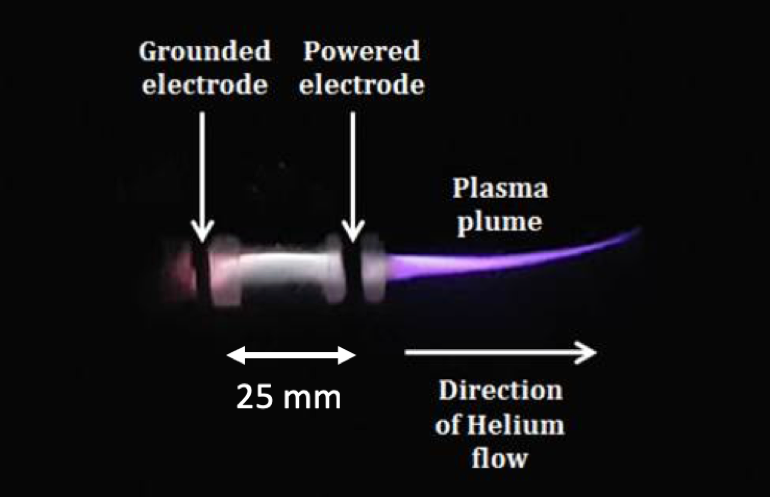Technological plasmas
Activity in technological plasmas at QUB focuses on the study of fundamental physical and chemical processes in low temperature plasmas and at the plasma-surface interface. This is primarily experimentally-based.
A gas is normally an electric insulator. However when a sufficiently large voltage difference is applied across a gap containing a gas or gas mixture then it will break down, become ionized and conduct electricity. The nature of the breakdown and the voltage at which this occurs varies with the gas species, gas pressure, gas flow rate, the materials and the nature, geometry and separation of the surfaces across which the potential difference is sustained, the separation distance of the electrodes, the nature of the high voltage supply (e.g. dc, ac, radiofrequency or microwave) and the actual electrical circuitry.
Discharges typically lead to only partially ionised gases containing electrons, ions and neutral atoms and/or molecules. The interactions of the electrically charged particles with each other, with the neutral gas, and with contact surfaces produce the unique physical and chemical properties of the plasma environment. However the momentum transfer between the light electrons and the heavier gas molecules and plasma ions is not very efficient and often the energy deposition into the plasma favours the electrons. As a result ionised gases, particularly at low gas pressures and charged particle densities, are described as non-thermal. This means that the constituents, for example the electrons, ions and gas molecules, are each in thermal equilibrium only with similar mass species. The velocity distribution of each species can be represented by a Maxwell-Boltzmann distribution and the energy distribution quantified by a temperature. However, often the electron temperature (Te ) is very considerably higher than the ion (Ti )and gas temperatures (Tg) i.e. Te >> Ti ~ Tg
In particular, research at QUB seeks to identify the basic processes that initiate and sustain cold atmospheric pressure plasmas and investigate their interactions with soft materials such as polymers and bio-materials for plasma medicine. We employ capillary jets operated in the kHz range producing relatively long plasma jets, which appear continuous to the naked eye, but on micro-second timescales are actually pulsed. The figure shows a photograph of a cylindrical dielectric barrier discharge jet. The discharge configuration consists of a glass tube with internal diameter 4 mm and thickness 1 mm. Tubular copper electrodes surround the glass tube and are driven at 20 kHz.
We also explore the production of discharges in and in close proximity to liquids. In liquids the discharge will produce intense electric fields, ions, radicals, UV radiation, as in a gas, but in addition they can produce voids and shock waves. Liquids can also be used as a dielectric in a high frequency Dielectric Barrier Discharge (DBD), putting it in intimate contact with the reactive, light producing discharge. While there has been work on these concepts for a number of years, it has been mainly empirical. We bring our experience in the plasma physics and chemistry of gas-phase discharges to bear on the study and development of liquid phase discharges. We are developing new approaches to the generation and application of liquid discharges. In particular we believe that additional gas injection may allow us to enhance or to change the physical and chemical environment in current systems. This could allow targeting of specific solutes and/or contaminants within water. Again based on our studies in high pressure gaseous plasmas we believe that the radical and the visible/UV light emission and the liquids electrical properties will all be very sensitive to impurities in the water which diffuse into the bubble.
We apply the techniques we have available to the study of water discharges, looking particularly at radical, UV production and visible light emission as well as the electric properties of the plasma. This programme was prompted by some work we undertook with a US plasma scalpel manufacturer.

A KHz driven plasma jet. The potential across the electrodes is 6 kV and pulsed at 20 KHz. Fast imaging and spectroscopy are used to investigate the plume.
RECENT PUBLICATIONS:
C. Mc Donnell,R. Irwin, S. White, W.G. Graham, D. Riley, Optical diagnosis of a kHz-driven helium, atmospheric pressure plasma jet, J. Plasma Phys., 88, 905880316 (2022)
L. Asimakoulas, W.G. Graham, F. Krcma, L. Dostal, K. R. Stalder, T. A. Field, Fast framing imaging and modelling of vapour formation and discharge initiation in electrolyte solutions, Plasma Sources Sci. Tech., 29, 035013 (2020)
